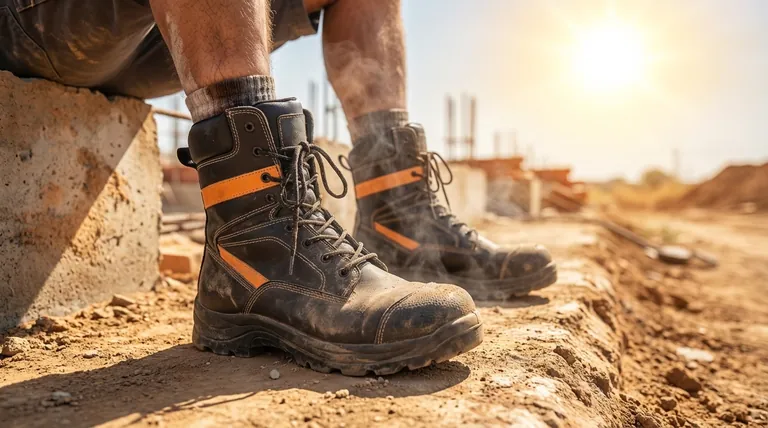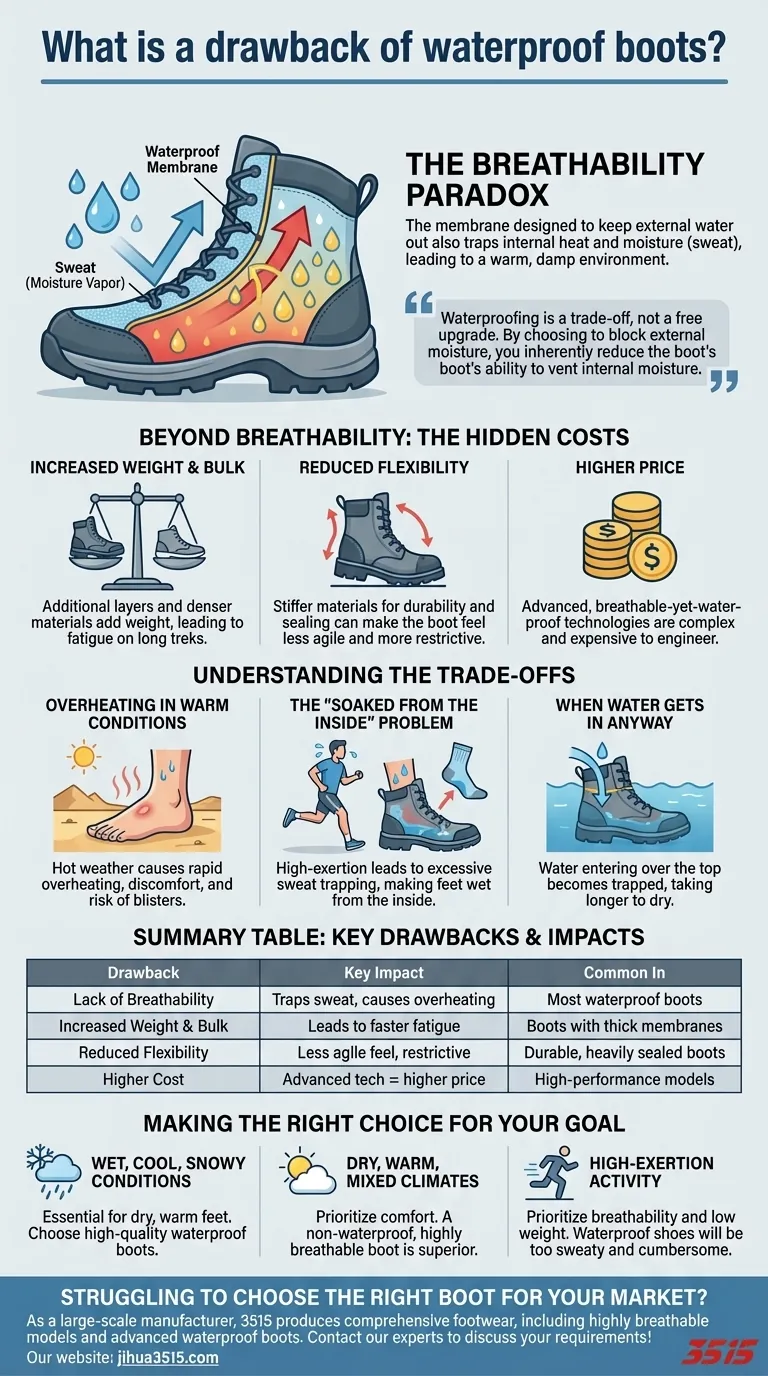The primary drawback of waterproof boots is a significant lack of breathability. The very membrane designed to keep external water out also traps internal heat and moisture (sweat). This creates a warm, damp internal environment that can lead to discomfort and sweaty feet, particularly in warmer weather or during strenuous activity.
Waterproofing is a trade-off, not a free upgrade. By choosing to block external moisture, you inherently reduce the boot's ability to vent internal moisture, which directly impacts comfort, weight, and foot health.

The Breathability Paradox
The core function of a waterproof boot creates its main weakness. Understanding how this works is key to choosing the right footwear.
The Role of the Waterproof Membrane
A waterproof boot contains a layer or membrane made of a material with pores too small for liquid water molecules to pass through. This is what keeps rain, snow, and puddle water out.
Trapped Heat and Moisture
Your feet are constantly producing heat and sweat, especially when you're active. In a non-waterproof boot, this moisture vapor easily escapes. In a waterproof boot, this vapor is trapped, creating a humid microclimate inside your footwear.
The Quality Spectrum
Not all waterproof membranes are equal. Higher-end boots use advanced materials with microscopic pores large enough to let water vapor (sweat) escape, but still small enough to block liquid water. Cheaper boots often use less sophisticated, non-porous materials like rubber, which offer almost zero breathability.
Beyond Breathability: The Hidden Costs
The focus on sealing the boot from water introduces other compromises in its design and performance.
Increased Weight and Bulk
Waterproof construction requires additional layers and often utilizes denser, less-porous materials. This inevitably adds weight and bulk compared to a non-waterproof equivalent, which can lead to fatigue on long treks.
Reduced Flexibility
The materials used to achieve waterproofing and durability are often stiffer than those in more breathable footwear. This can make the boot feel less agile and more restrictive, which may be unsuitable for activities requiring significant foot flexion.
The Price of Performance
Boots that successfully mitigate these drawbacks with advanced, breathable-yet-waterproof membranes and lightweight construction are complex to engineer. As a result, they are almost always more expensive than their non-waterproof counterparts.
Understanding the Trade-offs
A waterproof boot is a specialized tool, and using it in the wrong environment can be worse than having no waterproofing at all.
Overheating in Warm Conditions
In hot weather, the lack of air circulation becomes immediately apparent. Your feet will overheat quickly, leading to significant discomfort and an increased risk of blisters.
The "Soaked from the Inside" Problem
During high-exertion activities, you can sweat so much that your socks become soaked from the inside. In this scenario, the waterproof membrane has failed to keep your feet dry, even though no external water has entered.
When Water Gets In Anyway
If water goes over the top of your boot—for example, when crossing a deep stream—the waterproof design becomes a major liability. The membrane that prevents water from getting in also prevents it from getting out, trapping the water against your foot for far longer than a breathable, quick-drying boot would.
Making the Right Choice for Your Goal
Selecting the right footwear requires matching the technology to your specific environment and activity level.
- If your primary focus is hiking in consistently wet, cool, or snowy conditions: A high-quality waterproof boot is essential for keeping feet dry, warm, and protected from the elements.
- If your primary focus is hiking in dry, warm, or mixed climates: A non-waterproof, highly breathable boot will provide far superior comfort and prevent your feet from overheating and becoming sweaty.
- If your primary focus is high-exertion activity like trail running or fastpacking: Prioritize breathability and low weight; a waterproof shoe will almost certainly trap too much sweat and feel too cumbersome.
Ultimately, understanding that waterproofing is a specific tool for a specific job—not a universal upgrade—is the key to making the right choice.
Summary Table:
| Drawback | Key Impact | Common In |
|---|---|---|
| Lack of Breathability | Traps sweat, causes overheating | Most waterproof boots |
| Increased Weight & Bulk | Leads to faster fatigue | Boots with thick membranes |
| Reduced Flexibility | Less agile feel, restrictive | Durable, heavily sealed boots |
| Higher Cost | Advanced tech = higher price | High-performance models |
Struggling to choose the right boot for your needs?
As a large-scale manufacturer, 3515 produces a comprehensive range of footwear for distributors, brand owners, and bulk clients. Our production capabilities encompass all types of shoes and boots, including highly breathable models for warm climates and advanced waterproof boots that maximize comfort.
We can help you select or manufacture the perfect footwear to match your market's specific environment and activity demands, ensuring customer satisfaction.
Contact our experts today to discuss your footwear requirements!
Visual Guide

Related Products
- Premium Flame-Retardant Waterproof Safety Boots and Shoes
- Safety Footwear Wholesale Manufacturer for Custom OEM/ODM Production
- Wholesale Premium Waterproof Nubuck Safety Shoes Boots
- Heavy-Duty Waterproof Nubuck Safety Boots Safety Shoes for Bulk Supply
- Durable Waterproof Rain Boots | Custom Manufacturer for Wholesale & Brands
People Also Ask
- What are the advantages of rubber soles in safety boots? Unbeatable Grip & Durability
- What features make oilfield safety shoes resistant to heat and flames? Protect Against Extreme Temperatures
- How does repeated exposure to high temperatures damage safety boots? Avoid Costly Structural Failures
- What are the benefits of proper safety footwear beyond physical protection? Boost Productivity & Morale
- How do some boots combine materials for better performance? Achieve Superior Safety & Comfort



















